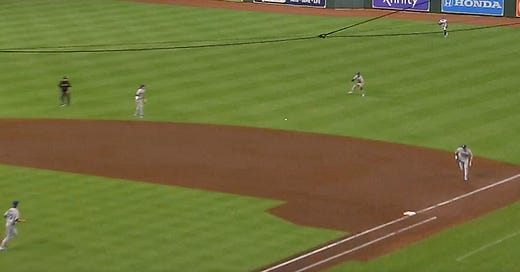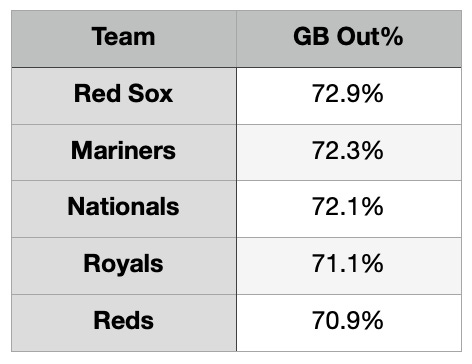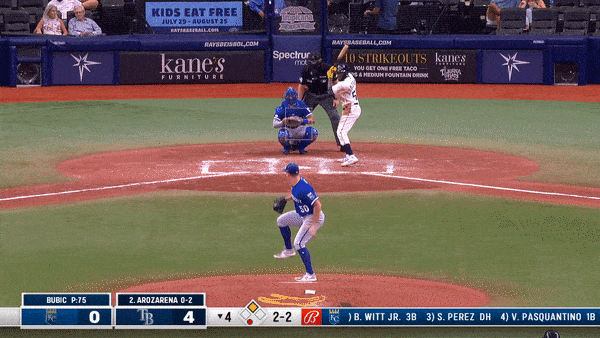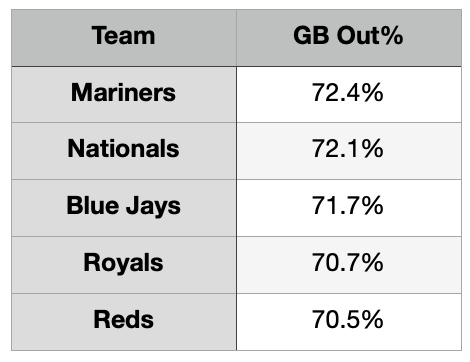MLB doesn't need this shift
Will the elimination of the shift and new runs mandating where infielders play impact the Royals and their defense in 2023?
Now that the World Series is over and we can start to focus on the upcoming 2023 season, one of the obvious subplots will be the elimination of the shift. The edict from commissioner Rob Manfred is meant to goose offense. There is already a debate underway as to whether banning the shift will have a meaningful impact in the intended manner.
Like most things the commissioner does for the good of the game, count me among the skeptics that this will have any kind of tangible impact. While I’m not necessarily a fan of three infielders on one side of second, that’s more about my own aesthetic tastes than anything analytical. It’s just…unbalanced. And that disturbs my sense of order.
Still, I’ve always been of the mind that if something like the shift works and it increases the chance your team will win, go for it. What Manfred is instituting will eliminate that rover-type in shallow right field snagging line drives that used to fall for a hit. It won’t prevent a shortstop from playing next to second base to snare a ball hit back up the middle. One step forward, one step back. It’s a defensive tango as mandated by the commissioner’s office.
Obviously, this will impact all teams. Some, likely more than others. And that’s what interests me about this new rule. How will it impact the Royals defense? (There’s also a question that can be asked about the offense, but that’s for another day.) Will the Royals convert fewer outs if they’re told not to shift? Or, like the arguments saying that there will be little impact on offense, will the Royals be basically the same team defensively with two infielders always positioned on either side of second?
It’s a question worth asking, I think.
Let’s start with the Royals and their history of shifting their infielders. Statcast has shift data going back to 2016. Here’s how the Royals have evolved over time in their deployment of the shift:
Kind of wild how the Royals went from 25th in using the shift in 2017 to fifth in the majors in the span of a single season. Ned Yost discussed the increase in an interview with The Athletic when asked what Pedro Grifol will bring to the White Sox as a manager who is versed in analytics.
But when the Royals wanted to implement more analytics in in-game strategy, Grifol served as the bridge between a research department that wanted a dramatic increase in defensive shifting, and Yost’s concerns about the opposition’s ability to pivot away from their tendencies when it was advantageous for them.
“He understands what made baseball the national pastime for over 100 years, but he also understands the new part of the game, the analytical part that can take players to a little bit of a different level if they can execute,” Yost said. “Pedro would get in there and break all that stuff down for me. He would help me understand exactly when we needed to do things. He helped me understand a lot of the basic analytical stuff because I didn’t come up in the analytical era. For me, a lot of this stuff was new, and he is extremely versed in all this.”
The 2018 season was a year when the Royals came out of the gates shifting seemingly constantly. My theory behind the increase is that since they broke up their core, they decided to go for broke and try new things. If it didn’t work, not much harm. If it did, that would be a bonus they could continue using through their rebuild. It turned out that while Yost may have bought in to the shift as a tool, they kind of moved away from it as the year rolled along. The decrease continued through 2019. I really don’t think Yost was a fan.
The 2020 season with 60 games was an anomaly. The Royals were fairly consistent in their deployment of the shift the last two seasons with Mike Matheny in charge. Still, they were well below league average, a gap that increased last year.
The Royals aren’t shifting as much compared to the league. Still, they position their infield in that manner about a quarter of the time. The key question is: Will the elimination of the shift help the Royals keep runs off the board?
Using ground ball data taken from Baseball Savant, we see the Royals were a very poor defensive team last year when their pitchers induced opposing hitters to hit a ground ball.
When the Royals aligned their infield in a “standard” position, they converted a ground ball into an out just 71.1 percent of the time. The league average was slightly above 75 percent. The bottom five teams converting ground balls to outs in a standard alignment:
Lest you think infield defense isn’t important, that’s four last-place teams…And the Mariners. There’s always an outlier to spoil a perfectly fine narrative. If I expanded the list to the worst 10 instead of the worst five, you would’ve seen four AL Central teams. The Guardians were the only above-average infield in the Central when playing “standard” defense at converting grounders into outs. Their success rate was 77.1 percent.
To break it down a little further, the Royals had an expected success rate of 76.6 percent, a gap of around five and a half percentage points. Only Cincinnati had a larger gap between expected and reality. The Royals’ infield defense when traditionally aligned was exceptionally poor in 2022.
Savant breaks down infield alignment into three categories. There’s the “standard” that’s above and then there’s the “strategic” shift. That’s defined as playing two infielders on each side of second (as the new rules in 2023 dictate), but with at least one fielder positioned outside of their traditional positioning. In other words, it’s a shortstop playing a step away from second base (allowed in 2023) or a second baseman positioned in the grass in short right field (not allowed in 2023). So this bucket of data isn’t exactly perfect for this purpose, but it’s the best we have.
Taking the “standard” alignment and combining it with the “strategic” infield alignment and the Royals are still firmly ensconced in the bottom five when it comes to converting ground balls into outs. And their success rate actually declines.
That decline in success rate wasn’t unique to the Royals. Most teams saw their success rate decline when folding the data from the “strategic” shift into the “standard.” The league average on converting ground balls to outs dropped to 74.8% when accounting for both alignments.
Again, this isn’t a perfect set of data. But this is something we can look at and say it’s close to how the Royals’ infield defense would’ve performed overall in 2022 if they were playing under the rules that will be in effect in 2023. It’s not promising.
Now the full shift…When teams deploy the shift they convert ground balls into outs 78.5 percent of the time. That’s an increase in success rate of around three and a half percentage points. In other words, it’s roughly three or four more outs per 100 batted balls on the ground. That’s why the arguments are made that outlawing the shift won’t appreciably increase offense.
However, for the Royals their success rate when shifting was a much better 77.8 percent. While that is still below league average (78.5 percent), that’s an increase of around seven percentage points for the team in converting ground balls into outs.
As noted, the league as a whole had a success rate of turning ground balls into outs of 78.5 percent. That’s an increase of 3.7 percentage points when shifting versus playing a “standard” or “strategic” infield alignment. The Royals outpaced the league average improvement when they played the shift.
The Royals were among the teams that deployed the shift the least, but there’s an argument that can be made that if they had used it a bit more frequently, they could’ve collected a few more ground ball outs.
There’s been plenty of discussion over the last month about the data, how most teams have the same data, and how the most successful teams deploy the data. As Yost mentioned in the quote above, it’s about distilling the information in a way that the players and the coaching staff understands what’s being asked of them. I was inclined to believe that Matheny was resistant to things like the shift as being too beholden to analytics and maybe just a little too new school; judging by how often the Royals shifted compartivley to the league, that seems to be the case. It’s too bad because while the infield consistently converted ground balls into outs below the league average, they were better when they deployed the shift.
As we move toward the 2023 season, it’s not necessarly useful to look at last year’s results to predict or project the future. For one thing, there is that overhaul in the Royals dugout. I would expect improved symbiosis between the analytics department and the field staff to yield better results going forward. Plus, there’s going to be different personnel on the Royals’ infield.
Like most of you, I was a bit surprised at how Bobby Witt Jr. struggled defensively. He was worth -4 Defensive Runs Saved at third base and posted an abysmal -18 DRS at shortstop. Baseball Savant had Witt at -3 Outs Above Average at third and -9 OAA at short. Maybe I’m drinking the Kool-Ade, but I expect Witt to improve his defense in his sophomore season. He’s just too skilled to consistently be as poor as the metrics (and to be fair, the eye test) graded him.
He will undoubtedly be helped by the return of Adalberto Mondesi. Maybe it’s insane to expect anywhere close to a full season from the Royals’ enigma, but if, by some miracle, Mondesi plays more than 130 games, the Royals’ infield defense improves by leaps and bounds on the left side. A combo of Witt at third and Mondesi at short should shore up that portion of the infield.
If Nick Pratto can break camp with the big league club, his insertion at first will pay defensive dividends. He only played 340 innings at the position last year, so didn’t register much in the way of DRS or OAA, but he’s earned raves for his glove as a prospect.
There’s also a question mark surrounding the second base position. Their cumulative -10 DRS at the position last year was third-worst in the majors. You may think the answer is to play Nicky Lopez at that position on the regular and the defensive problem is solved. Maybe. He finished with a -8 DRS last year at second. By that metric, Michael Massey was much better with a 1 DRS.
There will still be opportunities to strategically position defenders around the infield in 2023, and with new manager Matt Quatraro in the dugout, I expect the Royals to be aggressive as they can in utilizing a “strategic” shift. The underlying numbers may not suggest improvement, but if Mondesi can stay on the field and Witt improves with experience, the infield defense will improve.
Shift or no shift, there are reasons for optimism regarding the Royals’ defense in 2023.














Great info Craig. You talked a lot about Mondesi at shortstop like you expect him to be the starter there. I'm just not sure he is even going to be a factor next year on this team.